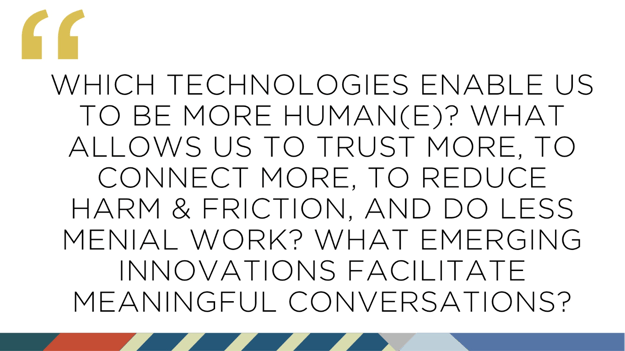Foresights and ideas that expand minds and inspire a change of heart.

Creating a sustainable future is fast becoming a crucial talking point for both companies and citizens around the world. In fact, 9 in 10 Australians have expressed concern—but how much of that sentiment translates into smart steps?
Swedish student Greta Thunberg made headlines at the last United Nations Climate Change Conference. Her cry for immediate action on the imminent climate crisis caused Australians to take to the streets, creating a groundswell of environmental awareness and support for a sustainable future. Although her speech has been met with criticism by climate change sceptics, creating a more energy-efficient society rings true not only for the environment and humans but also for the economy and companies' bottom lines.
Many backwards-looking businesses haven’t fully grasped how combining the best of human and robotic intelligence can save significant dollars whilst protecting our planet, too.
For example, when Apple released Liam—a recycling robot that deconstructs iPhones to mine the valuable resources inside—within the first year alone it had collected more than one tonne of gold from this recycling process and saved the tech giant millions of dollars. This highlights how implementing processes that focus on sustainability can have a range of beneficial outcomes.
From working alongside global brands to our own expert research, here are the exponential technologies that can help save the planet:
Turning ocean water into drinkable water is an extremely costly and energy-consuming process that is likely to harm marine life. However, a new sieve has just been created using graphene oxide that filters out the salt using less energy. This is a milestone product, considering it’s estimated that in less than a decade 14% of people will not have access to sufficient water resources where they live.
A significant amount of our products rely on pollination and need pollinators like bees to make them possible. However, with insects facing extinction, it is vital that we prepare for an alternate solution. Researchers are currently piloting a program where drones replace bees, which has so far proven to be positive. They are also working to create ‘robot bees’, which could work alongside real insects to increase the population and save the ecosystem.
‘Burgers for Biodiversity’ has been created to satisfy the demand for meat at a fraction of the environmental impact. Developed by Impossible Foods, this menu item requires 87% less water, releases 89% fewer greenhouse gases, and spares 96% more land than its meat alternative. This makes it a far more sustainable, scalable, and affordable way to make ‘meat’.
To address paper waste, Epson has developed a sustainable printing solution that allows large corporations to reuse and recycle their products. PaperLab upcycles used paper through the use of Dry Fiber Technology—which the printing solutions company calls "a way to create paper without using water". PaperLab creates 14 sheets of paper every minute, which is a huge amount for what would otherwise go to waste.
When applied to surface areas, solar paint captures energy from the sun before converting this into electricity. While it may look like normal paint, billions of pieces of light-sensitive material coat its surface, transforming it into energy-capturing paint. Installing solar paint only requires a technician, which drastically reduces the largest cost of the solar panel installation process. As the planet grows more solar-powered, solutions like solar paint will help us become less reliant on burning “dead dinosaurs” for energy or fuel.
In order to help the planet survive, companies and individuals need to leverage exponential technologies. We need to create and implement scalable, sustainable practices that benefit both the environment and our global economy.

Header Text
Lorem ipsum dolor sit amet, consectetur adipiscing elit, sed do eiusmod tempor incididunt ut labore et dolore magna aliqua. Ut enim ad minim veniam, quis nostrud exercitation ullamco laboris nisi ut aliquip ex ea commodo consequat. Duis aute irure dolor in reprehenderit in voluptate velit esse cillum dolore eu fugiat nulla pariatur.
Lorem ipsum dolor sit amet, consectetur adipiscing elit, sed do eiusmod tempor incididunt ut labore et dolore magna aliqua. Ut enim ad minim veniam, quis nostrud exercitation ullamco laboris nisi ut aliquip ex ea commodo consequat. Duis aute irure dolor in reprehenderit in voluptate velit esse cillum dolore eu fugiat nulla pariatur.
Lorem ipsum dolor sit amet, consectetur adipiscing elit, sed do eiusmod tempor incididunt ut labore et dolore magna aliqua. Ut enim ad minim veniam, quis nostrud exercitation ullamco laboris nisi ut aliquip ex ea commodo consequat. Duis aute irure dolor in reprehenderit in voluptate velit esse cillum dolore eu fugiat nulla pariatur.

Header Text
Lorem ipsum dolor sit amet, consectetur adipiscing elit, sed do eiusmod tempor incididunt ut labore et dolore magna aliqua. Ut enim ad minim veniam, quis nostrud exercitation ullamco laboris nisi ut aliquip ex ea commodo consequat. Duis aute irure dolor in reprehenderit in voluptate velit esse cillum dolore eu fugiat nulla pariatur.
Lorem ipsum dolor sit amet, consectetur adipiscing elit, sed do eiusmod tempor incididunt ut labore et dolore magna aliqua. Ut enim ad minim veniam, quis nostrud exercitation ullamco laboris nisi ut aliquip ex ea commodo consequat. Duis aute irure dolor in reprehenderit in voluptate velit esse cillum dolore eu fugiat nulla pariatur.
Lorem ipsum dolor sit amet, consectetur adipiscing elit, sed do eiusmod tempor incididunt ut labore et dolore magna aliqua. Ut enim ad minim veniam, quis nostrud exercitation ullamco laboris nisi ut aliquip ex ea commodo consequat. Duis aute irure dolor in reprehenderit in voluptate velit esse cillum dolore eu fugiat nulla pariatur.

Header Text
Lorem ipsum dolor sit amet, consectetur adipiscing elit, sed do eiusmod tempor incididunt ut labore et dolore magna aliqua. Ut enim ad minim veniam, quis nostrud exercitation ullamco laboris nisi ut aliquip ex ea commodo consequat. Duis aute irure dolor in reprehenderit in voluptate velit esse cillum dolore eu fugiat nulla pariatur.
Lorem ipsum dolor sit amet, consectetur adipiscing elit, sed do eiusmod tempor incididunt ut labore et dolore magna aliqua. Ut enim ad minim veniam, quis nostrud exercitation ullamco laboris nisi ut aliquip ex ea commodo consequat. Duis aute irure dolor in reprehenderit in voluptate velit esse cillum dolore eu fugiat nulla pariatur.
Lorem ipsum dolor sit amet, consectetur adipiscing elit, sed do eiusmod tempor incididunt ut labore et dolore magna aliqua. Ut enim ad minim veniam, quis nostrud exercitation ullamco laboris nisi ut aliquip ex ea commodo consequat. Duis aute irure dolor in reprehenderit in voluptate velit esse cillum dolore eu fugiat nulla pariatur.
& STAY UP TO DATE WITH FORESIGHTS AND TREND REPORTS!
WE WILL EQUIP YOU WITH THE VIDEOS AND MATERIALS YOU NEED TO SUCCESSFULLY PITCH ASN.
0 Comment